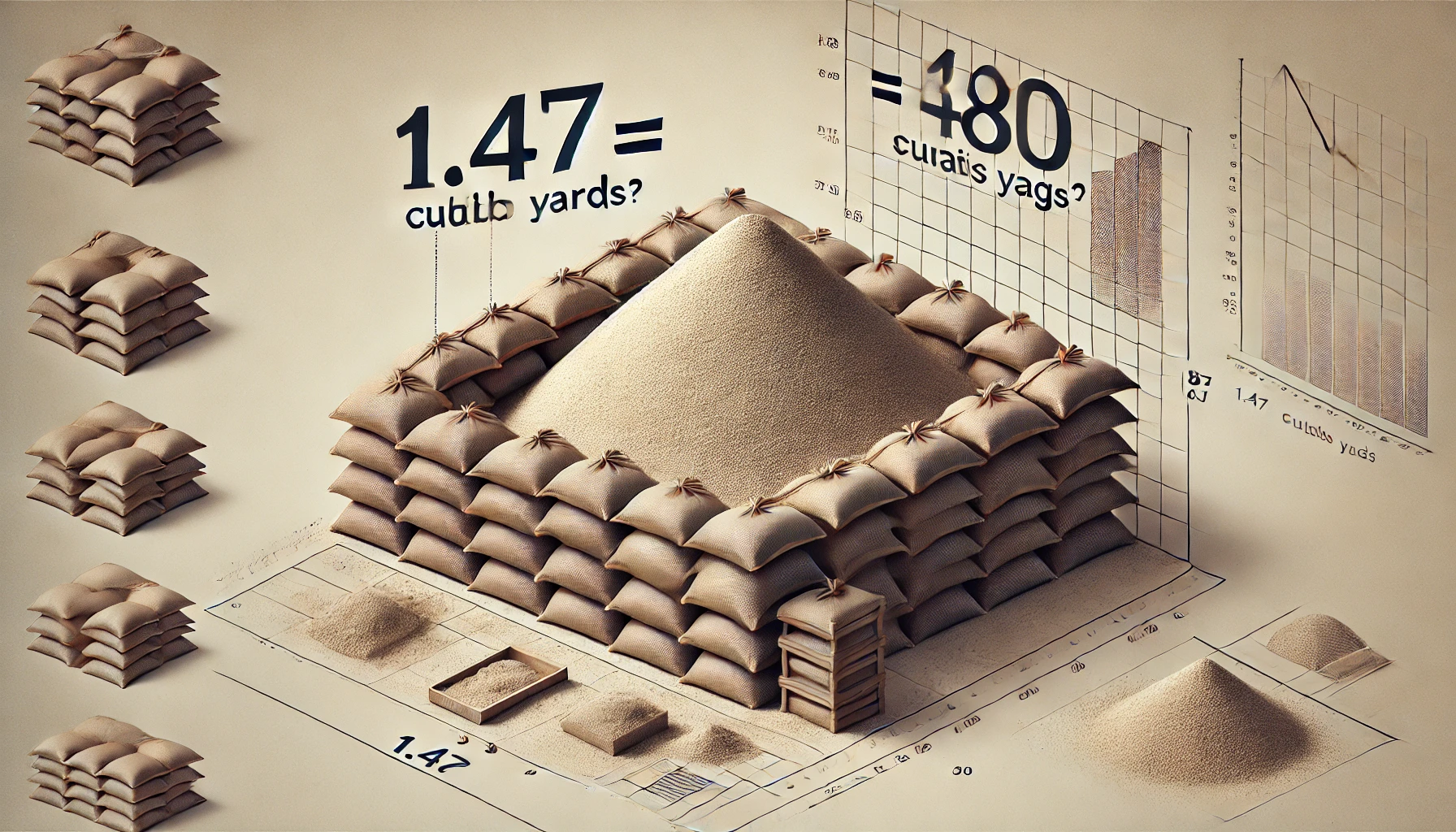
When planning a project involving sand bags, accurate calculations are essential to ensure you have the right amount of materials. Whether you’re building a foundation, shoring up flood defenses, or working on landscaping, the question “how many sand bags for 1.47 cubic yards” is critical. Understanding the relationship between sand bag capacities and cubic yards is the first step to success.
Table of Contents
A cubic yard is a measurement of volume equivalent to 27 cubic feet. Sand bags, on the other hand, come in various sizes, with the most common being bags that hold 0.5 cubic feet or 1 cubic foot of material. This means that knowing the size of your sand bags is essential before determining the exact number needed for 1.47 cubic yards. A project requiring this precise volume of material can become straightforward if you break it down step by step.
The volume of a single sand bag will determine how many are required to achieve your goal. For instance, if your sand bags hold 0.5 cubic feet each, you’ll need more than double the number compared to using larger 1-cubic-foot bags. Factors like compaction, settling, and wastage may also influence the final count.
How to Calculate the Number of Sand Bags Needed for 1.47 Cubic Yards
Calculating how many sand bags are needed for 1.47 cubic yards starts with understanding that one cubic yard equals 27 cubic feet. This means 1.47 cubic yards translates to 39.69 cubic feet (1.47 x 27).
If you’re using standard 0.5-cubic-foot sand bags:
- Divide 39.69 by 0.5 (volume per bag).
- The result is 79.38, which means you’ll need approximately 80 sand bags.
For larger, 1-cubic-foot bags:
- Divide 39.69 by 1.
- This gives you 39.69, or about 40 sand bags.
This calculation assumes no significant spillage or compaction during transport or use. However, it’s always a good idea to purchase extra bags as a contingency—experts recommend adding 5–10% more to your total to account for unforeseen circumstances.
Factors That Can Impact Your Sand Bag Requirements
While the math may seem straightforward, several real-world factors can influence how many sand bags for 1.47 cubic yards you’ll actually need. These include:
1. Sand Compaction
When sand is poured into bags, it can settle and compact, reducing the overall volume. The tighter the packing, the fewer bags may be needed, but this can also lead to uneven coverage.
2. Material Spillage
Handling sand can lead to small amounts of spillage, especially during transport or when filling the bags. While spillage may seem insignificant, it can add up quickly over a large project.
3. Bag Size Variations
Not all sand bags are created equal. Manufacturers may produce bags that slightly differ in volume due to their design or intended use, so check the exact capacity of your bags before purchasing.
4. Sand Type and Density
Different types of sand have varying densities, which can affect how much a bag can hold. For example, fine-grain sand may pack more densely than coarser varieties, requiring fewer bags.
5. Project-Specific Needs
The nature of your project may also dictate the number of bags required. For instance, creating levees or filling uneven ground may demand more sand than calculated due to irregularities in terrain or specific construction methods.
Choosing the Right Sand Bags for Your Project
Selecting the appropriate sand bags is crucial for efficiency and cost-effectiveness. The two most common options are:
1. 0.5-Cubic-Foot Bags
These smaller bags are ideal for projects requiring precise placement or maneuverability. They’re easier to handle but often require more labor due to the higher number needed.
2. 1-Cubic-Foot Bags
Larger bags are better suited for large-scale projects where volume and speed are priorities. However, they can be heavier and more challenging to transport.
The Role of Sand Bags in Construction and Flood Control
Understanding how many sand bags for 1.47 cubic yards you need is critical in industries like construction and disaster preparedness. In construction, sand bags are used for tasks like securing scaffolding, stabilizing soil, or creating temporary barriers. Similarly, in flood control, they form levees or protective walls to prevent water intrusion.
For such uses, precise calculations ensure efficiency and minimize waste, making them essential in both planning and execution.
Frequently Asked Questions
How do I calculate cubic yards for irregularly shaped areas?
To calculate cubic yards for irregular shapes, divide the area into smaller, measurable sections. Calculate the volume for each and then sum them up.
What type of sand is best for sand bags?
Coarse sand is typically recommended for sand bags, especially for flood control, as it drains water effectively and doesn’t compact easily.
How do I store unused sand bags?
Unused sand bags should be stored in a dry, cool location away from direct sunlight to prevent degradation.
Can sand bags be reused?
Yes, if the bags remain intact and uncontaminated, they can be reused for future projects.
Is it better to buy pre-filled sand bags?
Pre-filled bags save time but may be more expensive. For smaller projects, filling bags yourself is often more cost-effective.
How much does a single sand bag weigh?
A full sand bag typically weighs between 40–50 pounds, depending on the type of sand used.
Conclusion
Understanding how many sand bags for 1.47 cubic yards are needed can save time, money, and effort in your project. Whether you’re using 0.5-cubic-foot or 1-cubic-foot bags, simple calculations and considerations of real-world factors will help you achieve your goal efficiently. Always account for compaction, wastage, and project-specific requirements, and remember to select the right type of sand bags to suit your needs.
By following these guidelines and calculating your requirements accurately, you’ll ensure a smooth, cost-effective project with no unexpected shortages. So, get started today, and make your sand bag project a resounding success!

